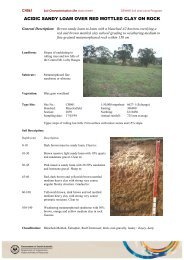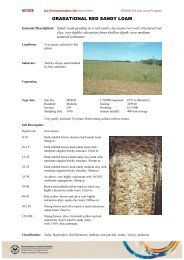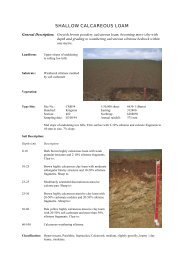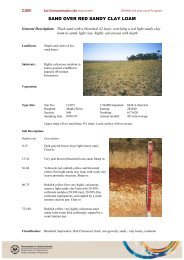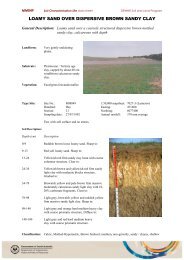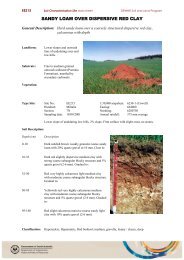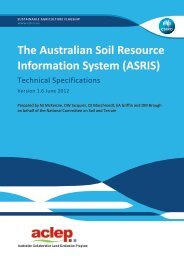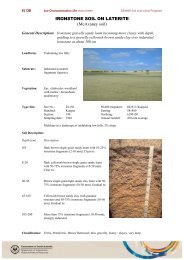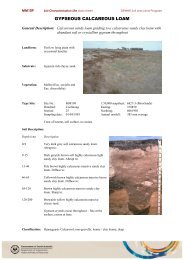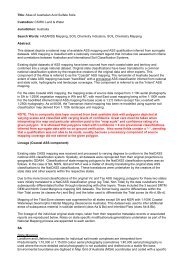SANDY LOAM OVER RED CLAY ON CALCRETE (Wudinna ... - asris
SANDY LOAM OVER RED CLAY ON CALCRETE (Wudinna ... - asris
SANDY LOAM OVER RED CLAY ON CALCRETE (Wudinna ... - asris
- No tags were found...
You also want an ePaper? Increase the reach of your titles
YUMPU automatically turns print PDFs into web optimized ePapers that Google loves.
EC057 Soil Characterisation Site data sheet DEWNR Soil and Land Program<strong>SANDY</strong> <strong>LOAM</strong> <strong>OVER</strong> <strong>RED</strong> <strong>CLAY</strong> <strong>ON</strong> <strong>CALCRETE</strong>(<strong>Wudinna</strong> soil)General Description: Thin to medium thickness sandy loam over a red sandy clay loam tosandy clay on calcrete within 50 cmLandform:Gently undulating dunefieldof low to moderate parallelsandhills.Substrate:Calcrete.Vegetation:Mallee.Type Site: Site No.: EC057 1:50,000 mapsheet: 6031-3 (Kopi)Hundred: Warramboo Easting: 567400Section: 22 Northing: 6319950Sampling date: 1992 Annual rainfall: 335 mm averageSoil Description:Stony swale between low sandhills. Soft surface.Depth (cm)Description0-10 Brown soft sandy loam. Sharp to:10-11 Dark yellowish brown light sandy clay loam.Sharp to:11-17 Dark reddish brown massive fine sandy clay loam.Abrupt to:17-22 Yellowish red massive slightly calcareous lightclay. Abrupt to:22-30 Yellowish red weakly structured very highlycalcareous light clay. Sharp to:30- Calcrete.Classification: Haplic, Petrocalcic, Red Kandosol; medium, non-gravelly, loamy / clayey, shallow
EC057 Soil Characterisation Site data sheet DEWNR Soil and Land ProgramSummary of PropertiesDrainage:Fertility:pH:Rooting depth:Well drained. Except where there are no fractures in the calcrete, the profile rarelyremains wet for more than a day or so following heavy or prolonged rainfall.Inherent fertility is moderate. Clay content, calcium saturation and associated nutrientretention capacity are favourable, although regular phosphorus applications areessential. Nitrogen levels depend on legume status of pastures and cropping history.Zinc levels are low at sampling site.Alkaline throughout.30 cm in pit.Barriers to root growth:Physical:Chemical:The calcrete prevents virtually all deeper root growth except through fractures.There are no chemical barriers.Waterholding capacity: Approximately 40 mm in the rootzone.Seedling emergence:Workability:Satisfactory.Soft to firm surface is easily worked although surface stone interferes with andabrades equipment.Erosion Potential:Water:Wind:Low.Low.Laboratory DataDepthcmpHH 2 OpHCaC1 2CO 3%EC1:5dS/mECedS/mOrg.C%Avail.Pmg/kgAvail.Kmg/kgSO 4 Boronmg/kg mg/kgTrace Elements mg/kg(DTPA)Cu Fe Mn ZnCECcmol(+)/kgExchangeable Cationscmol(+)/kgCa* Mg Na KESP0-10 7.9 7.6 5 0.20 0.92 - - - - 1.4 0.32 - 6.52 0.34 6.10 4.46 0.89 0.02 0.57 0.310-11 - - - - - - - - - - - - - - - - - - - -11-17 8.2 7.7 5 0.25 0.92 - - - - 2.6 0.90 - 6.67 0.26 17.20 - 3.14 0.25 1.40 1.517-22 8.4 7.8 7 0.30 0.94 - - - - 3.6 1.64 - 3.74 0.29 21.40 - 7.13 0.49 1.30 2.322-30 8.4 7.9 12 0.44 1.69 - - - - 5.1 2.37 - 5.50 0.36 23.30 - 10.83 1.13 1.15 4.830+ - - - - - - - - - - - - - - - - - - - -Note:CEC (cation exchange capacity) is a measure of the soil's capacity to store and release major nutrient elements.ESP (exchangeable sodium percentage) is derived by dividing the exchangeable sodium value by the CEC.* Exchangeable calcium (Ca) values not presented for lower layers due to use of inappropriatelaboratory procedure.Further information: DEWNR Soil and Land Program




